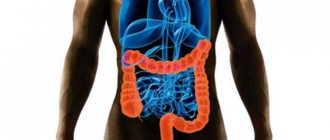If a person suddenly begins to have a stomach ache, constipation or bloody discharge from the intestines, then the first thing he should do is consult a proctologist. This specialist will advise diagnostics, but the patient may ask how to check the intestines without a colonoscopy? This is understandable, because no one wants to endure the pain and consequences of a colonoscopy.
List of ailments that can be identified during examination
How to check the intestines in other ways?
There are various ways and methods in which you can conduct a bowel examination without a colonoscopy. Conventionally, they can be divided into invasive and non-invasive.
The first analogues include:
- Finger method of intestinal examination;
- Irrigoscopy;
- Anoscopy;
- Recotoromanoscopy;
- Capsule diagnostics.
The essence of each of these examinations is to examine the intestines from the inside using various devices, tubes, endoscopes and other things.
Examining the intestines using any of these methods will be less painful than using a colonoscopy, but discomfort will still be felt.
Non-invasive methods include:
- Ultrasound examination (ultrasound);
- Computed tomography (CT);
- Magnetic resonance imaging (MRI);
- Virtual colonoscopy;
- Endorectal ultrasound;
- Positron emission tomography.
When performing any of this list of intestinal examinations, the patient will not feel pain or unpleasant consequences of the procedure. However, such a check is not an alternative to colonoscopy, but only a possible addition .
The fact is that colonoscopy shows the presence of a tumor even at an early stage, reveals fissures and fistulas and is a more informative diagnostic test. And its main advantage is the ability to take a biopsy for oncology and remove various polyps and anomalies.
Therefore, you should not try to replace colonoscopy with any other methods of examining adults and children. It is better to supplement it than to explore it with other methods.
Pros and cons of colonoscopy
Colonoscopy refers to endoscopic methods for detecting cancer, polyps and other pathological processes. Diagnostics has a number of advantages:
- allows you to get an accurate picture of what is happening in the intestines;
- a complete overview of the organ and its loops;
- possibility of performing a biopsy;
- During the procedure, bleeding can be stopped, polyps and small tumors can be removed;
- The duration of the diagnosis is no more than half an hour.
However, colonoscopy also has disadvantages. It is necessary to carefully prepare for the examination, otherwise the results may be unreliable and secondary diagnostics will be required.
Colonoscopy is not a painless procedure. It is performed under strong sedatives or anesthesia, which not all patients can tolerate. This diagnosis is contraindicated for heart failure (as well as liver and pulmonary), colitis, peritonitis, as well as acute infections and poor blood clotting.
Finger method of intestinal examination
Any appointment with a proctologist begins with an examination of the external part of the anus and external genitalia.
If there is no rash, pigmentation or other symptoms of the disease, the doctor feels the anus and rectum from the inside. To do this, putting on a medical glove, he inserts one or two fingers inside and probes the intestinal walls for cracks or tumor growths. He also helps himself by pressing down on the patient's lower abdomen with his other hand.
After this check, the doctor prescribes a more specific examination depending on which organ pathology is suspected:
- large intestine;
- small intestine;
- sigmoid colon;
- rectum.
Is it possible to do an ultrasound of the intestine instead of a colonoscopy?
This is a very common question from patients after they are scheduled for a colonoscopy. It is necessary to understand that although these methods examine the same organ, their capabilities differ. Video colonoscopy is indispensable if you suspect intestinal cancer or specific inflammatory processes (Crohn's disease or ulcerative colitis), where a biopsy determines further treatment tactics.
Ultrasound of the intestines is a general examination and is prescribed to all patients with gastroenterological pathologies.
Irrigoscopy
This is a classic and commonly used method of examining the intestines using a barium enema and x-ray. This method checks the large intestine. At the preparatory stage, you need to do an enema or take a laxative to cleanse the gastrointestinal tract of food debris.
After filling the intestines with barium, an x-ray is taken from several angles: lying on the stomach and on the side.
Next, the specialist examines the received images and renders his verdict. Usually this study is prescribed for dolichosigma - suspected volvulus. In this case, the picture is quite specific and no outside diagnosis is required.
Read more about this method here.
Photo:
Anoscopy
This method uses an anoscope to examine the anus and identify diseases of the rectum.
This is a mandatory procedure before prescribing colonoscopy and sigmoidoscopy.
Patient preparation is the same as for irrigoscopy. In the hospital, the patient lies on the couch on his side or takes a knee-elbow position.
The doctor inserts the anoscope to a depth of about 10 cm . If dangerous pathologies are found and basic diagnostics cannot be carried out, then they choose what to replace colonoscopy with.
Sigmoidoscopy
This is a more painless procedure than a colonoscopy, but also aims to examine the colon. The advantage of this event is that during the examination, tumors and polyps can be removed using the special functions of the sigmoidoscope. The principle is the same as for anoscopy, only a longer section of the intestine is examined, about 30 cm in depth .
But this informative diagnostic method also has its drawbacks, namely:
- sensitivity when inserting an endoscope;
- possible injuries to the intestinal mucosa;
- abdominal pain for 24 hours after the procedure.
Read a detailed description of the procedure here.
Colonoscopy - the essence of the method
The essence of a colonoscopy is to examine the intestines from the inside using a probe that is inserted into the rectum. The tool is equipped with a mini camera with a flashlight. This allows you to get a good look at the insides of the organ and immediately remove stones and polyps. The duration of a colonoscopy is approximately 30 minutes. The examination helps to identify the presence of:
- polyps;
- inflammation;
- malignant neoplasms;
- swelling of large veins;
- infectious diseases;
- diverticula.
If necessary, during a colonoscopy, a tissue sample is taken to test whether the tumor is malignant. The examination requires serious preliminary preparation - following a diet and cleansing the intestines. Colonoscopy is contraindicated if:
- colitis;
- poor blood clotting;
- pulmonary, cardiac or liver failure;
- acute intestinal infections;
- peritonitis.
If there are contraindications, video colonoscopy is replaced by alternative research methods.
Capsule diagnostics
Although this is an invasive procedure, it is absolutely painless for the patient. The patient swallows a small tablet-camera and it, entering the organs of the gastrointestinal tract (GIT), takes many pictures and transmits them to a special sensor.
The camera can capture things that you cannot see with endoscopy.
However, there is a risk that it will remain in the stomach and be difficult to remove, but in most cases this does not happen and the camera exits through the anus during bowel movements.
Capsule endoscopy is not yet a very common analysis, since it is not done in all hospitals and is quite expensive.
Ultrasonography
Almost everyone knows what ultrasound diagnostics is. But the fact that intestinal examination can also be carried out using ultrasound is a new thing for most. To do this you need to prepare specially:
- 12 hours before the ultrasound do not eat;
- do an enema a few hours before, or take a laxative at night;
- Do not urinate two hours before the ultrasound.
The examination itself is carried out using an ultrasound machine and contrast injected into the intestines through the anus.
Doctors look at the bowel before urinating (with a full bladder) and after bowel movement to see how the intestinal wall reacts as it stretches and contracts.
Which is better, ultrasound or colonoscopy?
Even an experienced specialist will not be able to answer this question for you. Why? Because these are two different types of bowel examination that can complement, rather than replace, each other. You can make a list of the advantages and disadvantages of these examinations, but what is more significant is up to you to decide.
| Ultrasonography | Colonoscopy | ||
| Advantages | Flaws | Advantages | Flaws |
| Painless | Difficulty in preparation | Less expensive | Difficulty in preparation |
| No side effects such as pain or even internal injuries | The gaps in the folds are not always visible | Possibility of biopsy and removal of polyps | There are unpleasant and even painful sensations |
| The entire intestine is examined completely, even remote areas | Tumors smaller than 1cm are difficult to detect | Detection of tumors at early stages | Possibility of injuring the intestinal mucosa |
| Unlimited number of examinations | Information content | ||
It is impossible to say which of these intestinal examinations is better. But you can choose priority indicators for yourself and focus on them.
Clinical picture in later stages
The clinical manifestations of this disease are very diverse, so it is impossible to base the diagnosis on them alone. There are no pathognomonic symptoms of intestinal tumors, that is, those that are characteristic only of this disease.
We will touch on the main groups of clinical manifestations of colorectal cancer to show how diverse the symptoms of these diseases can be. The following groups of clinical manifestations are distinguished:
- toxic-anemic symptoms;
- dyspeptic disorders;
- signs of enterocolitic inflammation of the intestine;
- signs of obstruction of the intestinal lumen by a tumor;
- pseudo-inflammatory symptoms.
Toxic-anemic symptoms
With the development of a tumor in the intestinal lumen, signs of a violation of the integrity of its wall appear. As a result of this, microorganisms located nearby can penetrate the intestinal wall and cause local inflammation. In this case, systemic phenomena develop, which are referred to as intoxication syndrome.
This is manifested by decreased performance and increased fatigue. Nausea, headache, drowsiness, and weakness may occur. At the same time, there is an increase in body temperature.
Anemic syndrome develops due to regular blood loss through the damaged intestinal wall. Outwardly, this is manifested by pallor of the skin and mucous membranes. According to laboratory tests, there is a decrease in hemoglobin levels and other indicators. As a result, the patient’s performance and general well-being also decreases. Compensatory tachycardia appears and breathing quickens.
With this condition, the patient may be given a false diagnosis, for example, arthritis, inflammation of the upper and lower respiratory tract, myocarditis, etc.
Dyspeptic disorders
With the development of a tumor and damage to the intestinal wall, the receptors located there are irritated, resulting in an increase in intestinal motility as a reflex. In addition, activation of pain receptors occurs as a result of the appearance of small ulcers on the intestinal mucosa or as a result of tumor metastasis into surrounding tissues and organs.
Dyspeptic symptoms are manifested by severe abdominal pain, indigestion (nausea, vomiting, belching). The latter is due to the fact that toxins affect the sphincter located at the entrance to the stomach. As a result, its tone decreases. Another manifestation of dyspepsia is the appearance of diarrhea or constipation. All this may be accompanied by fever, that is, an increase in body temperature.
These clinical manifestations are nonspecific - a similar picture is observed in many other intestinal diseases. For example, with appendicitis, cholecystitis, pancreatitis and other conditions that arise from inflammation in the abdominal cavity.
Symptoms of enterocolitic inflammation of the intestines
When toxins enter the bloodstream, they are carried throughout the body. They also enter the thickness of the mucous membrane of the colon. As a result, symptoms associated with impaired intestinal function are added to the picture of general intoxication.
This is manifested by the following symptoms:
- fever, which in its course resembles that of various intestinal infections and food poisoning;
- diarrhea or constipation;
- bloating and rumbling in the stomach due to increased fermentation processes in the colon;
- increased tone of smooth muscle fibers in the intestines, which leads to pain in the abdomen. This especially often occurs immediately after eating, resulting in decreased appetite and possible weight loss;
- impurities in the stool in the form of mucus, pus or blood.
Under normal conditions, when there is no proper oncological alertness towards the patient, these phenomena can be confused with a disease such as dysentery or other inflammatory bowel diseases.
Intestinal obstruction
As the tumor progresses and metastasizes, intestinal obstruction may develop. The severity of the condition usually increases due to the fact that when tumor cells grow into the intestinal wall and inflammation occurs, adhesions are formed that tightly bind the intestinal loops, preventing them from straightening out. The result is an acute condition requiring urgent surgical treatment.
Before signs of irreversible intestinal obstruction appear, symptoms appear that indicate the presence of partial obstruction of the intestinal lumen. This includes a constant feeling of heaviness in the abdomen, which may intensify after eating and be accompanied by nagging pain. Long-term constipation may also occur that does not go away after taking a laxative or using an enema. Pain may occur after the procedures described above, as intestinal tone increases and smooth muscle spasms occur.
This condition also occurs with diverticulosis, intestinal obstruction of another origin (for example, due to adhesive disease after operations on the gastrointestinal tract).
If the small intestine is involved in the tumor process, then the clinical picture is much more pronounced. An acute condition occurs, with symptoms similar to intestinal volvulus or intussusception. In addition to the pain syndrome, uncontrollable vomiting occurs, often with food just eaten, and a rapid increase in signs of intoxication.
Pseudo-inflammatory symptoms
These manifestations are characteristic of later stages of development of the tumor process, when metastasis occurs to other internal organs: ovaries, lungs, etc. Usually during this period, a tumor in the intestine can be palpated through the anterior abdominal wall.
This group of symptoms has the following manifestations:
- fever;
- constant abdominal pain, intense, often the patient cannot indicate its specific location;
- stool disorders in the form of constipation, signs of intestinal obstruction;
- bloating;
- an admixture of pus or blood in the stool;
- clinic of damage to other internal organs, for example, if the lungs are affected, then a persistent debilitating cough occurs that does not go away after taking antitussives.
conclusions
We considered ten survey options. Which can replace a colonoscopy. Many of them are expensive but painless, others are informative but have unpleasant consequences. But it’s hard to say whether they can replace intestinal colonoscopy. Here, the decision to prescribe this or that type of examination must be made by the doctor .
He will examine your symptoms and complaints, and then prescribe an examination that will help establish a diagnosis reliably and in the least painful way.











